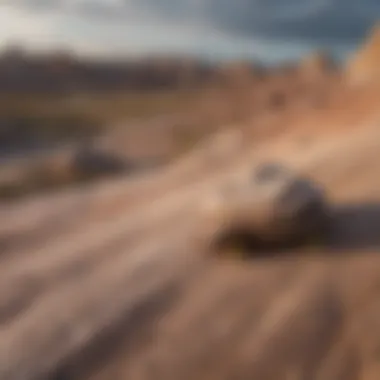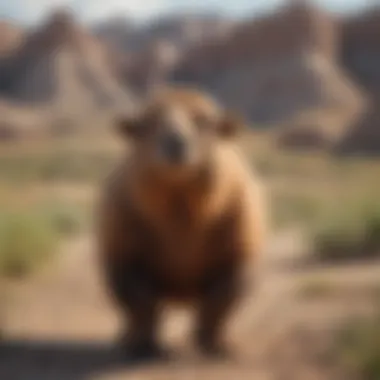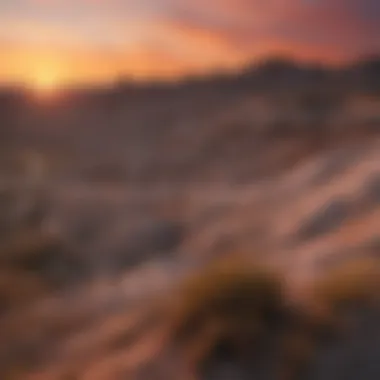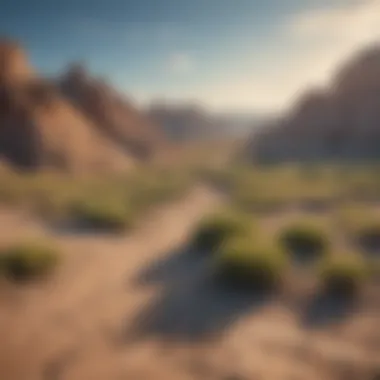Exploring the Badlands: Nature's Masterpiece


Nature Topic Overview
The Badlands of South Dakota is a unique place in the United States. Known for its rugged landscape, it presents a stunning mix of canyons, sharp peaks, and colorful rock formations. The area is rich in history and serves as a natural laboratory for earth sciences. With its striking beauty, it invites exploration and education about geology and ecology.
This place is not just about rocks and soil. The Badlands are also home to many plants and animals, making it an important ecosystem. Understanding this environment helps us appreciate the complexities of nature and the need for conservation.
Visitors come to see the unusual rock layers formed millions of years ago. These layers offer a glimpse into the Earth’s history. Fossils found here tell us about ancient creatures that roamed the land long ago. As you wander through the Badlands, it is essential to keep in mind the delicate balance of this habitat, and why it is vital to protect it.
"The Badlands National Park is a gift to the world, showcasing some of the most breathtaking geological formations and wildlife in the country."
Fun Facts and Trivia
Learning about the Badlands can be fun! Here are some interesting facts:
- The Badlands are home to some of the oldest fossils in North America.
- The colorful layers of rock show different periods of geological time.
- The park covers over 242,000 acres of land.
- More than 400 species of plants grow in the Badlands.
With these facts, young readers can see how special this place really is. Activating curiosity can lead to wonderful discoveries.
Wildlife Explorations
The Badlands are not just beautiful; they are alive with wildlife. Many species find their home in this distinct landscape. Some notable animals include:
- Bison
- Pronghorn
- Coyotes
- Various birds like the Golden Eagle
The wide-open spaces and varied terrain make it a great home for these animals. Observing them in their natural habitat can be an exciting experience for anyone visiting.
Environmental Awareness
The Badlands teach us the importance of protecting our environment. Conservation is key. Each species, big or small, plays a role in the ecosystem. Here are some ways to help:
- Reduce, reuse, and recycle materials.
- Participate in local clean-up events.
- Respect wildlife and their habitats when exploring.
Teaching children these values is essential. It will create a generation that cares for nature.
DIY Nature Activities
Engaging with nature can be hands-on! Here are some fun activities.
- Fossil Making: Use clay to create fossil impressions. Press objects into the clay, then let it dry to mimic real fossils.
- Nature Scavenger Hunt: Create a list of plants and animals to find during outdoor explorations.
These activities encourage creative thinking and appreciation for the outdoors. It allows young minds to connect with what they see around them.
Prelude to the Badlands
The Badlands of South Dakota hold a profound significance in the realm of natural history and environmental education. This unique region offers a window into the Earth’s past, showcasing intriguing geological formations and rich biodiversity. Understanding the Badlands is essential not only for appreciating its beauty but also for grasping the larger ecological systems at play. The diverse landscapes found here encourage education, exploration, and the importance of conservation efforts on a local and global scale.
Location and Geography
The Badlands National Park is located in southwestern South Dakota, encompassing a vast area of approximately 244,000 acres. It is positioned east of the Black Hills and is bordered by several towns, including Wall and Interior. The geography of the Badlands is striking. Visitors encounter sharply eroded buttes, pinnacles, and deep gorges, all of which contribute to its dramatic scenery. The park is characterized by a mix of grasslands and rugged terrain, creating a unique ecosystem that supports various forms of wildlife.


Moreover, the elevation in this area ranges from around 2,000 to 3,000 feet, which influences the climate and weather patterns. One notable feature is the light-colored rock layers that dominate the landscape. This layered effect results from sediment deposition over millions of years.
"The Badlands reveal the earth's geological history through its stunning rock formations, making it a natural classroom for all visitors."
Formation and Geological History
The geological history of the Badlands goes back approximately 69 million years. Formed during the late Cretaceous period, this region is primarily made up of sedimentary rocks. The complex processes of erosion and deposition have sculpted the landscape we see today. The ancient seas that once covered this area contribute to the rich fossil beds, where the remains of prehistoric creatures can be found.
Throughout history, volcanic activity influenced the geology as well, as materials from eruptions became part of the sediment layers. These various processes have created the Badlands' distinctive formations, such as the well-known "Badlands Wall," a steep escarpment that runs along the park’s northern edge.
Overall, the dynamic processes of nature have shaped the Badlands into a dramatic landscape filled with important geological features that tell a story of Earth’s past.
Unique Geological Features
The Badlands region in South Dakota is renowned for its unique geological features. These elements not only shape the landscape but also tell a rich story of the earth's history. Understanding these formations enhances appreciation and fosters respect for this stunning area.
Rock Formations
The Badlands are famous for their striking rock formations, which exhibit an array of colors and textures. These formations arise primarily from sedimentary rocks, including sandstone, siltstone, and claystone. Over millions of years, natural processes like erosion created cliffs, deep canyons, and sharp pinnacles.
Some well-known formations include:
- The Yellow Mounds, which showcase vibrant yellow colors due to sulfur and iron compounds.
- Castle Butte, a prominent landmark rising from the landscape, attracting visitors with its towering presence.
- Fossil beds that provide insight into ancient life. The findings include bones from dinosaurs and other prehistoric creatures.
These formations are not merely aesthetic. They offer clues about the environmental conditions that existed millions of years ago. Visitors can explore these features through trails that navigate the rugged terrain. It's essential to respect these formations as they are a crucial part of our planet's geological history.
Erosion and Landscape Changes
Erosion plays a vital role in shaping the Badlands' striking landscape. Wind, rain, and temperature fluctuations constantly affect the rocks, leading to gradual changes over time. The soft layers of rock erode faster than harder layers, resulting in unusual shapes. This ongoing process creates a landscape that constantly evolves.
Key factors affecting erosion include:
- Weather patterns: Intense rain can cause rapid erosion, changing the landscape in significant ways.
- Wind: Strong winds can wear down rock surfaces, sculpting them into various forms.
- Human activity: Though minimal, tourism can impact erosion. Visitors should stay on designated paths to minimize disturbance to these natural features.
The beauty of the Badlands lies in its dynamic character. Each visit can reveal new formations or changes that were not present before. Observing how nature crafts these features is a profound experience, connecting us to the Earth’s past and present.
"The Badlands are a reminder of the power of natural forces and the beauty of impermanence."
Recognizing the importance of these geological features fosters a deeper connection to the landscape and encourages a commitment to its preservation for future generations.
Biodiversity in the Badlands
Biodiversity plays a crucial role in maintaining the ecological balance in the Badlands of South Dakota. It includes the variety of life forms, encompassing both plants and animals found in the region. High biodiversity ensures healthier ecosystems and provides essential services to humans. The intricate relationships among various species contribute to the resilience of the environment, making it more capable of withstanding changes and disturbances.
Flora of the Badlands
The flora of the Badlands is unique and adapted to the harsh conditions of the area. The plant life consists of numerous species that thrive in poor soil and limited moisture. Notable plants found here include:
- Grasses: Species like needlegrass and bluestem dominate the landscape, providing habitat and food for many animals.
- Cacti: Prickly pear and other cacti showcase fascinating adaptations to conserve water.
- Shrubs: Sagebrush and rabbitbrush are common and play vital roles in the ecosystem by providing cover for small mammals.
These plants not only sustain wildlife but also prevent soil erosion, which is essential in such a rocky environment. Their deep roots help to anchor the soil and create stability. Additionally, some plants like the sunflowers bloom vibrantly, attracting pollinators, which are vital for the reproduction of many species.


Fauna of the Badlands
Fauna in the Badlands consists of a wide array of species, some of which are iconic representations of North America. The region is home to:
- Bison: Often seen grazing in the prairie. These large animals play a role in shaping the grassland ecosystem.
- Bighorn Sheep: These agile climbers can be found in the rocky outcrops, adapted perfectly to their habitat.
- Prairie Dogs: Their burrows create complex systems that provide homes for other animals and improve soil quality.
Birds also flourish in this ecosystem; species like the golden eagle and western meadowlark are commonly spotted. The presence of such diverse fauna indicates a rich environment that supports various life forms. Protecting this biodiversity is vital not only for the animals themselves but also for the overall health of the ecosystem.
"Biodiversity is the foundation of ecosystem services; it is the key to the sustainability of our planet."
In summary, protecting the flora and fauna of the Badlands is essential. Each species contributes to the overall ecosystem's health, making conservation efforts crucial in this unique environment.
Cultural Significance
Understanding the cultural significance of the Badlands of South Dakota is essential to appreciate its role in history and identity for various groups. The Badlands is not just a remarkable natural landscape; it represents a profound connection to the cultural heritage of the Native American tribes and pivotal historical events that shaped the region. Exploring this significance provides insights into human relationships with nature, the lessons of resilience, and the value of preserving cultural identity.
Native American Heritage
The Badlands have long been home to several Native American tribes, most notably the Lakota Sioux. For these tribes, the land holds spiritual meaning and serves as a vital resource. The Badlands are rich in stories and legends passed down through generations.
The Lakota people consider the land sacred. Their traditional practices and worldview emphasize their connection to nature. They believe that the land provides numerous resources, including food and medicine. Understanding these elements helps in recognizing the importance of the Badlands beyond physical beauty.
Tribal educational programs are prevalent in the area, allowing children and families to learn about the Lakota culture. Visitors can even join guided tours led by Lakota elders. These programs emphasize storytelling and language, giving a deeper context to the land's significance.
Historical Events
The history of the Badlands is marked by significant events that have shaped its current status. In the late 19th century, the region was involved in the struggle between Native American tribes and European settlers. Conflicts arose due to land disputes and broken treaties.
One major event was the Battle of Wounded Knee in 1890, which occurred not far from the Badlands. This event resulted in the tragic loss of many lives and marked a crucial turning point for Native American rights. Understanding this history is vital. It stands not only as a reminder of struggles faced but also emphasizes the ongoing fight for cultural recognition and environmental rights.
Additionally, the area attracted explorers and settlers hoping to profit from its resources. The discovery of fossils and unique geological formations made the Badlands a subject of scientific interest. This attention eventually led to the establishment of Badlands National Park, protecting these resources and the history intertwined with them.
Overall, the Badlands serve as a powerful symbol of cultural resilience and a reminder of the complexities that come with progress and preservation. When exploring this region, one must acknowledge its rich heritage and strive to understand the various narratives that it encompasses.
Visitor Experiences
The Visitor Experiences section serves as a critical element in understanding what the Badlands offer to families and educational groups. This region is not just a place for viewings. Instead, it promotes hands-on engagement with nature and history. Visitors can explore the dramatic landscapes while learning about geology, plant and animal life, and preservation efforts.
Many parents and educators seek destinations that provide educational value. The Badlands meet that need, as they allow children to interact with their surroundings. Whether hiking, camping, or participating in programs, each experience enriches their understanding of the natural world.
Trails and Hiking
Hiking through the Badlands provides an opportunity to appreciate the natural beauty and unique geology firsthand. The diverse trails cater to varied skill levels and ages, ensuring that everyone finds a suitable path. Some notable trails include
- Notch Trail: A challenging hike featuring a stunning view from a high ledge. It teaches patience and endurance.
- Window Trail: A shorter walk, perfect for families. It leads to a beautiful rock formation that feels otherworldly.
- Castle Trail: The longest trail offers an immersive experience in the Badlands’ vibrant landscapes, highlighting the geological formations.
Each trail reveals different aspects of the environment. As children walk along the paths, they can learn about the distinct layers of sedimentary rock. They may also spot various wildlife. Parents should ensure their kids have proper footwear and water to stay safe and comfortable.
Camping and Accommodations


For those wanting to extend their visit, camping brings a night under the stars. The Badlands National Park provides campgrounds like Cedar Pass Campground. It's fully equipped with basic amenities. Camping allows families to bond over stories by a fire, and children can discover the joys of adventure in the wild environment.
When staying at the campgrounds, expectations should be set. There are no plugs for electronics, and visitors should prepare for a rustic experience.
- Safety Tips:
- Alternatives: There are several nearby hotels and cabins available. Each provides proximity to the park, ensuring a comfortable stay while allowing easy access to explore.
- Keep food secure to avoid attracting wildlife.
- Ensure children stay close and follow park rules.
Educational Opportunities
Understanding the educational opportunities in the Badlands of South Dakota is vital for young learners. This unique region is more than just a picturesque landscape; it serves as a dynamic classroom for children and adults alike. Engaging with the Badlands offers a deeper appreciation of geology, ecology, and the region's rich cultural history. Such experiences can foster a lifelong love for nature and science.
Guided Tours and Programs
Guided tours in the Badlands provide structured learning experiences led by knowledgeable park rangers or naturalists. These professionals share valuable insights about the geology, flora, and fauna of the area.
- Types of Tours: There are various types of tours available, catering to different interests. Some focus on archaeology, while others emphasize wildlife or plant species.
- Hands-On Learning: The opportunity for hands-on interaction is significant. Many tours include activities like fossil digging or plant identification. Children can learn by doing, making the experience memorable.
- Family-Friendly Options: Many programs are designed with families in mind. Families can enjoy fun activities together while learning about the environment.
- Group Discounts: For larger groups such as schools or clubs, discounts may be available, making these tours accessible to wider audiences.
Interactive Learning Resources
Interactive learning in the Badlands enhances the educational experience by using technology and hands-on activities.
- Visitor Centers: The visitor centers typically offer interactive displays. These may include touch screens with information about ecosystems or animations that explain geological formations.
- Educational Workshops: Periodically, workshops may be offered in collaboration with schools. These workshops often involve experiments or projects that relate to the local environment.
- Digital Resources: Many park services provide online tools and apps. These can help visitors learn even before their trip. They usually include quizzes, facts about the Badlands, and ways to engage with the natural world.
- Field Guides: Children can use field guides to identify plants and animals. This is a great way to get involved in the ecosystem. Parents can foster curiosity by asking their children to locate various species while exploring.
Engagement with the Badlands through educational opportunities supports a connection to nature that can last a lifetime. This learning not only informs but also encourages a sense of responsibility toward conservation. > "The best way to learn is to engage with the environment directly, and the Badlands provide ample opportunities for such experiences."
By taking advantage of guided tours and interactive resources, families can deepen their understanding of this remarkable region. As they explore the visitor centers and participate in educational programs, they help cultivate a generation that values and protects our natural resources.
Environmental Conservation
Environmental conservation is a crucial topic related to the Badlands of South Dakota. This stunning region is not just a backdrop for adventure; it is a vital ecosystem that requires attention and care. Without conservation efforts, both the unique landscape and the myriad of species will face severe threats. Educating ourselves and others about the importance of protecting this environment ensures that we can enjoy the Badlands not only today but for generations to come.
Importance of Preservation
Preserving the Badlands means protecting its unique geological formations, native plants, and animals. Here are some key reasons why preservation is necessary:
- Biodiversity Loss: The Badlands host numerous species. Loss of habitat leads to diminishing populations. This affects the whole ecosystem.
- Climate Change: The region is not immune to climate change. Altered weather patterns can harm the ecosystem's health.
- Cultural Heritage: The land has historical and cultural significance. It is vital we maintain these aspects for future generations to learn from.
"Every small action counts when it comes to preservation. Not just scientists, but everyone can play a role in saving the Badlands."
Community Involvement
Community involvement is essential for effective environmental conservation in the Badlands. Local residents, organizations, and visitors all have roles to play. Some ways to get involved include:
- Volunteering: Participate in local clean-up events or habitat restoration projects. Many park services organize these activities, and they are open to all ages.
- Education: Encourage schools to incorporate environmental education into their curricula. Teaching children about the Badlands can inspire future conservationists.
- Advocacy: Support local policies that protect natural resources. Speak up for conservation initiatives both online and within communities.
Engaging the community creates a sense of ownership and pride in preserving the Badlands. This teamwork fosters a protective attitude towards the area and spreads awareness about environmental issues.
Epilogue
The Badlands of South Dakota hold a unique place in both the natural world and the history of the United States. This conclusion wraps up key elements discussed in this article, underlying the importance and relevance of the Badlands.
The Future of the Badlands
Looking ahead, the future of the Badlands hinges on effective conservation efforts. As development pressures increase, maintaining the landscape's integrity and health becomes crucial. Local communities, government agencies, and visitor involvement are all vital in this regard. Educating the public about the significance of the area fosters a sense of responsibility towards its preservation. Constant monitoring of wildlife and plant life ensures that we can protect this unique ecosystem. Incorporating sustainable tourism practices will also help mitigate environmental impacts.
"Preserving places like the Badlands is not just about protecting land; it's about safeguarding our natural heritage for future generations."







